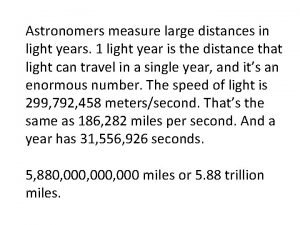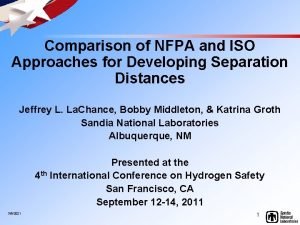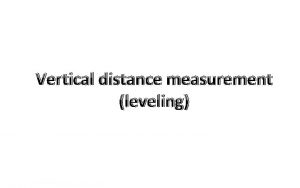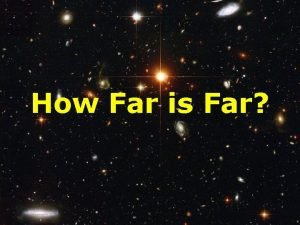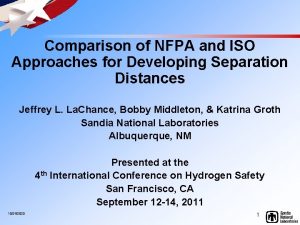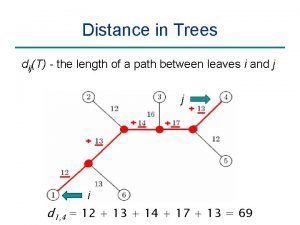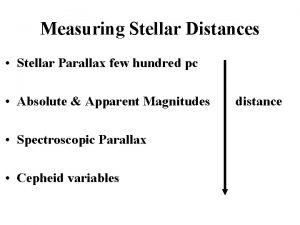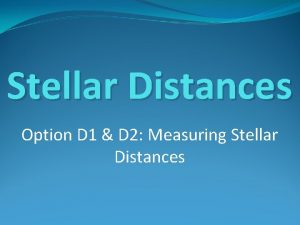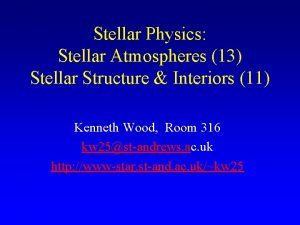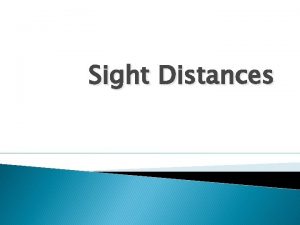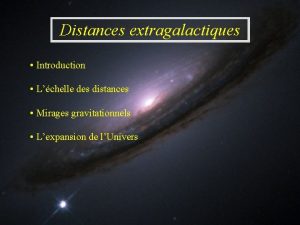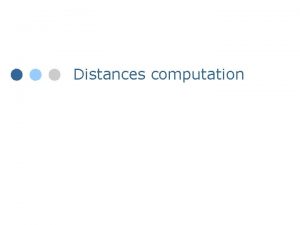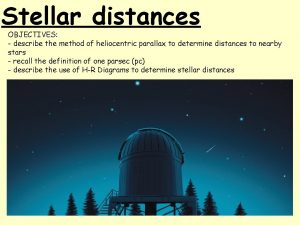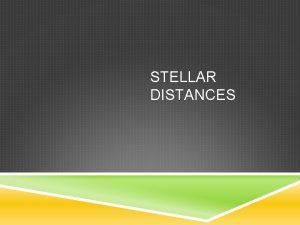Stellar Distances SLHL Option E 3 Its the


















- Slides: 18

Stellar Distances SL/HL – Option E. 3

It’s the ship that made the Kessel Run in less than 12 parsecs

What is a Parsec? (pc) • A unit of distance that we use for determining the distance of stars • It is calculated using the diagram here • It is defined as the length of the adjacent side of an imaginary right triangle in space. • The two dimensions that specify this triangle are the parallax angle (defined as 1 arcsecond) and the opposite side (which is defined as 1 astronomical unit (AU), the distance from the Earth to the Sun). • Given these two measurements, along with the rules of trigonometry, the length of the adjacent side (the parsec) can be found.

Parsec and Friends Unit Equals 1 AU 1. 46 x 1011 m 1 ly 9. 46 x 1015 m 1 ly 63240 AU 1 pc 3. 086 x 1016 m 1 pc 3. 26 ly 1 pc 206265 AU

Stellar Parallax • The apparent shifting of a distant object against a stationary background when viewed from two different perspectives • Think about looking out of a window with a plant on the sill. As you walk past the window the object will appear to move relative to the background outside.

Parallax • The shift is very slight relative to the “fixed” stars behind the observed star but sufficient for distant stars… but not too distant (100 pc or less) • Formula: d = 1/p, where d is the distance to the star and p is the parallax angle

Limitations of the Parallax method • Stars that are too far away will not show enough parallax to calculate their distance • Viewing stars from a space-based position helps to eliminate some of the error and increase the range, but at some point the error in the system equals or exceeds the angle being measured • Beyond that, other methods can be used

Apparent Magnitude • Over 2000 years ago a Greek astronomer named Hipparchus devised a 6 point scale for the brightness of stars. – 1 being the brightest stars in the sky – 6 being the dimmest stars, barely visible to the naked eye • We still basically use this scale and more precise measurements have given value to his numbers

Apparent Magnitude • The difference between 1 and 6 (a magnitude of 5) equates to a brightness of 100 x • This actually translates to each change in 2. 512 x brightness at each level – So a 3 is 2. 512 x as bright as a 4 and 6. 31 x as bright as a 5 – 100 stars of magnitude 6 would be as bright as 1 magnitude 1

Apparent Magnitude • The change we have made to the scale is the allowance of larger numbers and negative numbers • The sun is a -26. 8 and Pluto is a 15. 1 • The formula for the ratio of apparent brightness and apparent magnitudes is:

Absolute Magnitude, M • Apparent magnitude is based on how objects look from Earth • To standardize the apparent magnitude and thereby get a a measure of the actual luminosity, scientists “place” all objects at 10 pc • The apparent magnitude at this distance is called the absolute magnitude • The formula here is:

Estimating Luminosity • For the stars beyond the distance at which parallax is useful, we can use the measureable brightness and the spectral type of the star to estimate luminosity using Wien’s Law and the HR diagram

Determining Stellar Distances • Now that we have the luminosity and brightness we can use an earlier formula to determine the distance to these far off stars

Limitations of Spectroscopic Parallax • This method is sometimes called spectroscopic parallax • This method becomes limited by the error in the determination of the luminosity, which becomes too large at great distances and the method’s accuracy drops off beyond the sensible amount • The limit for this is 10 Mpc

The Cepheid Variable • As we have previously discussed, the Cepheid Variable is a type of star that has a luminosity that varies over time • Recall that this is due to the outer layers of the star undergoing a periodic expansion and contraction, causing a variation in the surface temperature and surface area. • The S-B law states:

Period and Absolute Magnitude • We have discovered that a relationship exists between the period of a Cepheid Variable’s brightness and the luminosity of the star • Cepheid Variables are quite bright (about 10000 x the luminosity of the sun) and so are easy to locate

The Standard Candle • The ability to know the magnitude of the star based on its period means we can also determine the distance even if it is beyond the 10 Mpc limits we usually encounter • It also means that we can use that star as a reference or standard candle to compare the other stars in, say, another galaxy or to determine the distance to that galaxy • This method is limited to 60 Mpc

An example problem • A Cepheid (δ) is 300 pc from Earth (found by parallax). Another variable is seen in a different galaxy with the same period but with an apparent brightness of 10 -9 of δ. How far is the other galaxy from Earth?
 Slhl
Slhl Long call short call
Long call short call Konvergensi option adalah
Konvergensi option adalah The furthest distance i've travelled
The furthest distance i've travelled Astronomers measure large distances
Astronomers measure large distances Horizontal movement of air is called
Horizontal movement of air is called Nfpa separation distances
Nfpa separation distances How to measure vertical distance
How to measure vertical distance Ted likes to run long distances
Ted likes to run long distances Far distances
Far distances Which blow over long distances?
Which blow over long distances? Distances
Distances Winds that blow over longer distances build up bigger
Winds that blow over longer distances build up bigger Distance per time
Distance per time Images of weather systems on television come from *
Images of weather systems on television come from * A simple pendulum of length 40 cm subtends 60
A simple pendulum of length 40 cm subtends 60 Gas particles are separated by relatively large distances
Gas particles are separated by relatively large distances Nfpa separation distances
Nfpa separation distances Tree distances i
Tree distances i




